Forests are some of the typical habitats where birds with blue tails live. These types of birds can be rare due to them being either captured or facing issues such as a diminishing habitat.
The Americas, Europe, Asia, and Australia are among the continents with different species of blue-tailed birds.
They have tails that measure anywhere between a quarter of an in and up to 5-6 inches, depending on each species.
Their majestic tails are in full display when perching. In some of the following named species, their blue tails can be even longer than the body.
Here are some of the representative birds with blue tails in different nuances from azure to navy. These birds are active for a short period or throughout the year.
Table of Contents
1. Blue-Tailed Bee-Eater
An Asian native, Blue-Tailed Bee-Eaters (Merops philippinus) are among the species with long blue tails in the world.
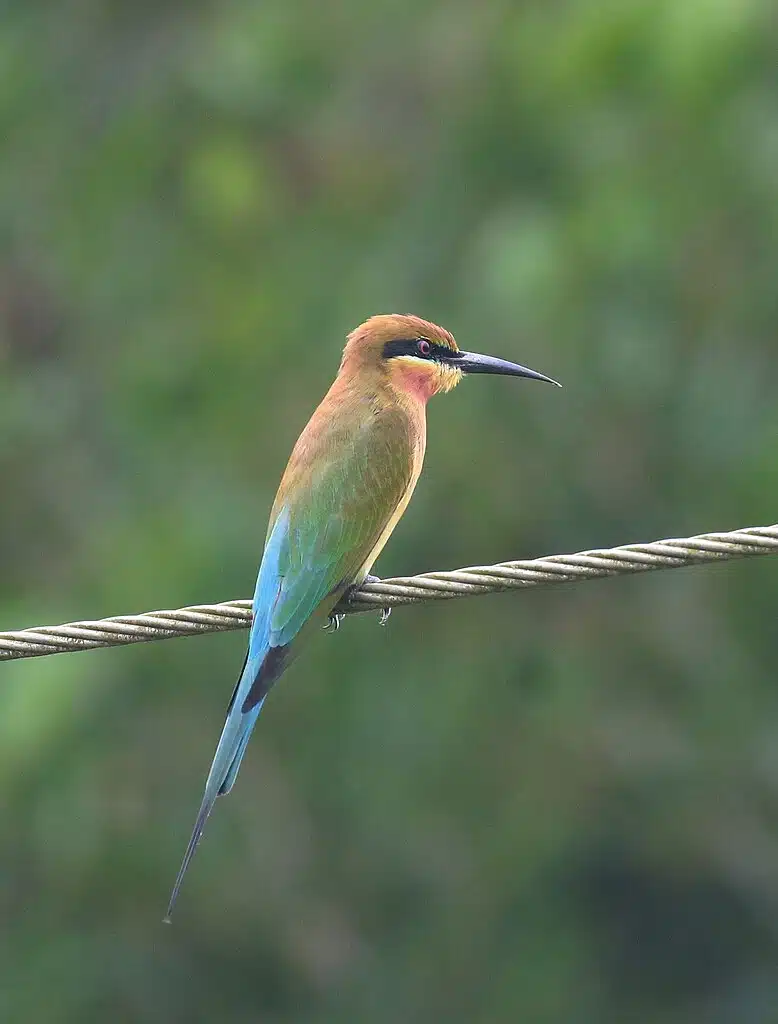
While mostly green, they exhibit bright blue tails and matching stripes along the eyes.
From India to Thailand, these birds are seen seasonally, as strong migrators. They move out on their own but breed in colonies in their thousands.
Blue-tailed Bee-Eaters don’t eat bees alone, as they can also feast on other insects such as dragonflies.
Identified by their long blue tails, the presence of these birds in a habitat is typically a worrying sign. While small (they only grow to a maximum of 10 inches) they can eat many pollinating bees.
While bees make up the bulk of their diet, they may also be slightly beneficial by eating parasitic wasps.
2. Blue-Tailed Trogon
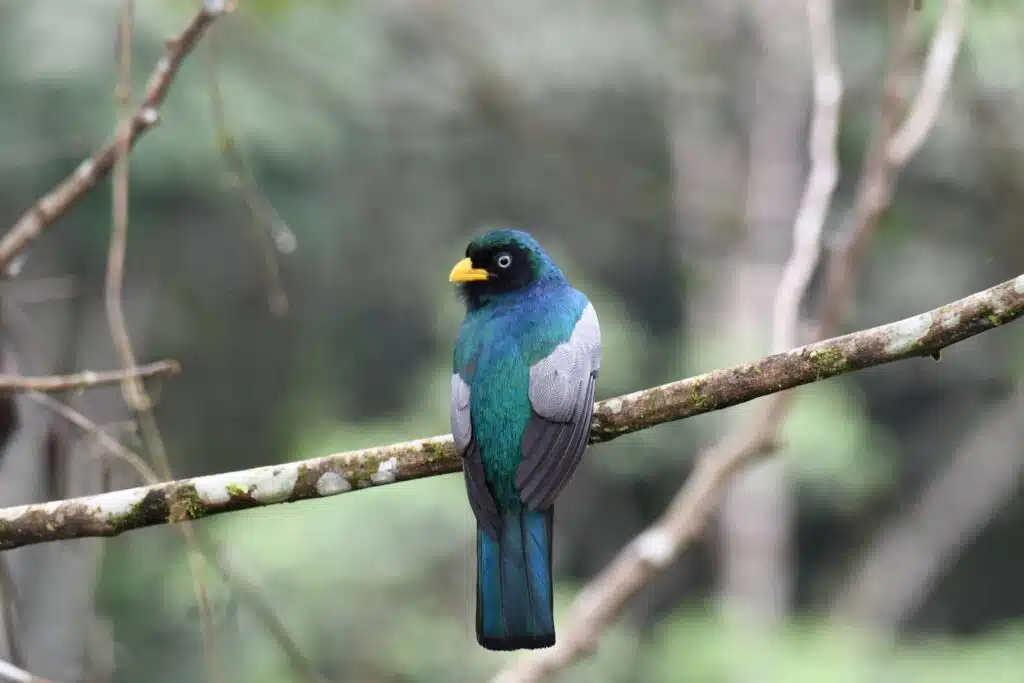
A dark blue tail is specific to these species of birds that grow to 11 inches.
Purple-blue nuances are seen on its tail, dorsum, and cap. Red and gray plumage dominates the rest of its appearance.
The Blue-Tailed Trogon (Trogon comptus) is further known for its repetitive vocalizations and for eating spiders, insects, and fruit.
Birds of the species spend their days up on trees, only flying out rarely for food.
This species may be spotted due to its orange beak as its dorsal plumage is dark.
Some of the most common habitats of the species include the dense forests of Colombia and Ecuador.
3. Blue-Tailed Hummingbird
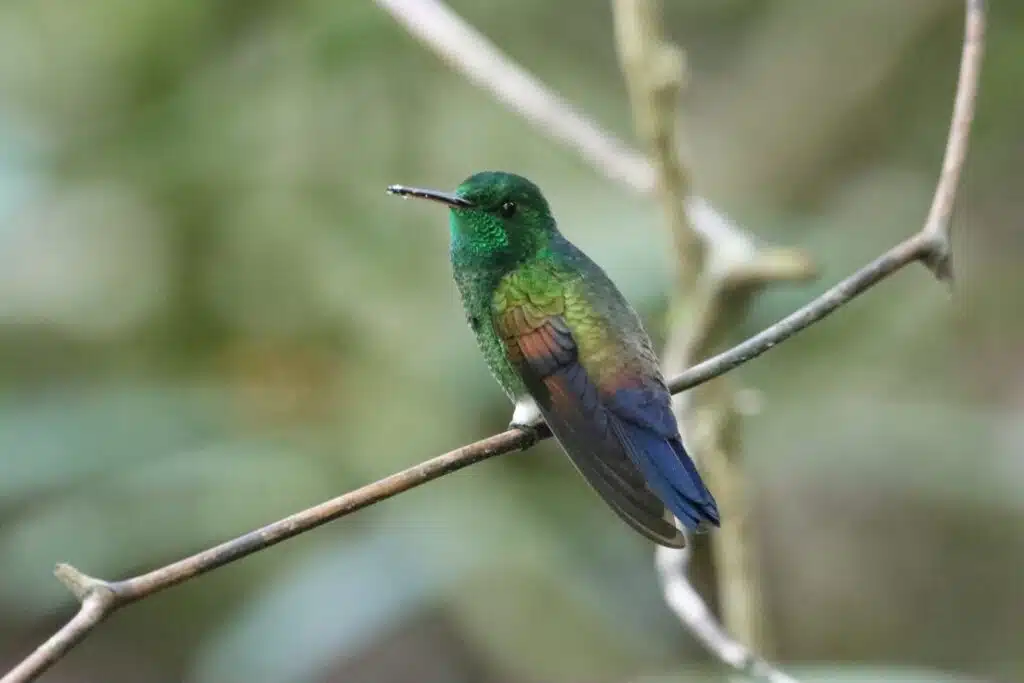
Long blue tails are specific to The Blue-Tailed Hummingbird (Saucerottia cyanura), a species of The Americas.
This tropical type of bird has dark blue tails longer than 2 inches. The rest of its plumage is mostly metallic green and gray.
Its long blue tail is on display when spread open in flight.
Females tend to be a bit less colorful and closer to gray plumage than to green-dominant plumage.
Living in tropical forests, The Blue-Tailed Hummingbird is mostly seen in Southern Central America.
Some of the countries it inhabits include Guatemala, Honduras, El Salvador, Nicaragua, and Costa Rica.
4. Blue-Tailed Emerald
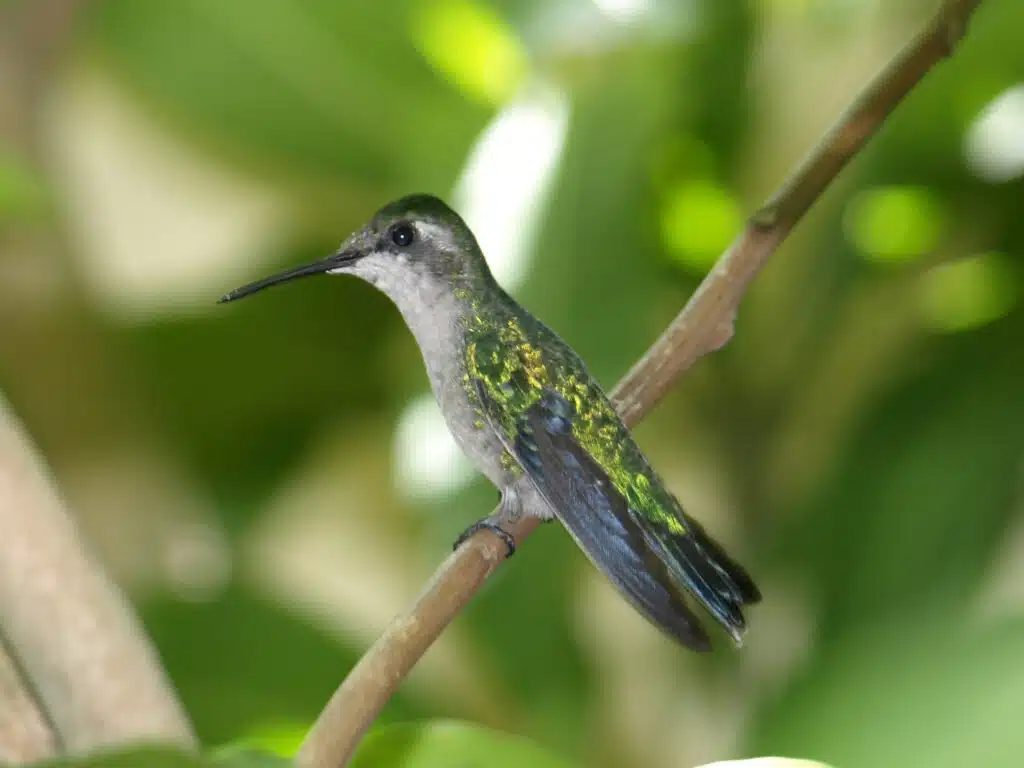
Colorful male Blue-Tailed Emeralds (Chlorostilbon mellisugus) feature blue tails. They show blue upper tails and blue undertail coloring which they display when hovering.
Birds of this species have distinct emerald-green coloring with iridescence. Less colorful females show extra gray sections on the underside while males become even more colorful in the breeding season.
Feeding on flower nectar and on insects, these birds reach a maximum size of 3.7 inches and show a tendency to become more colorful in the breeding season.
The typical male also shows a blue pattern on the chest when breeding, possibly to attract more females.
Feeding on pink, yellow, and orange flowers, Blue Tailed Emeralds are mostly a species of Northwestern South American forests.
They can be found from Colombia to Suriname and down to Bolivia.
5. Red-Flanked Bluetail
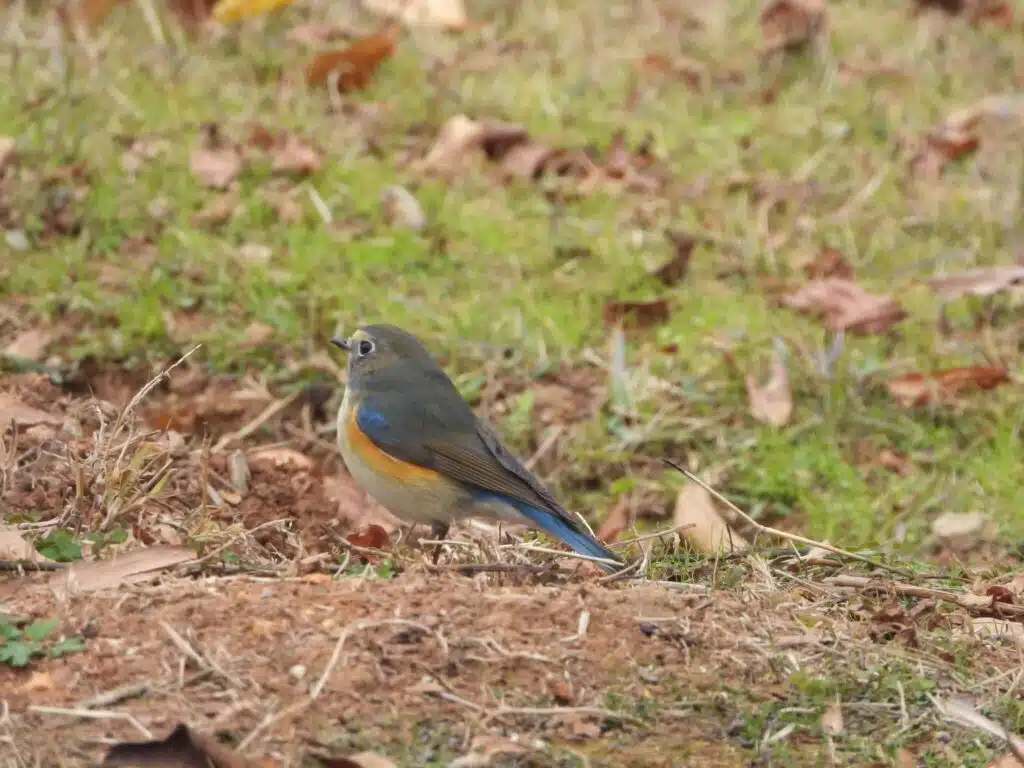
Native to Asia, The Red-Flanked Bluetail (Tarsiger cyanurus) also lives in forests. All types of forests are home to this small species.
Males are dominated by blue plumage with matching dark navy blue tails.
Females are brown and gray, with yellow lateral plumage also seen along the chest of males.
As males, females also show blue tails that measure up to 2 inches.
Mostly found across Siberia and East China, the species is believed to be expanding its territory. It has already reached Southeast Asia and the outskirts of Northern Europe.
Specialized in feeding on insects, Red-Flanked Bluetails spend a lot of time either on trees or on the ground where they can catch flies, bugs, and ants.
6. Himalayan Bluetail
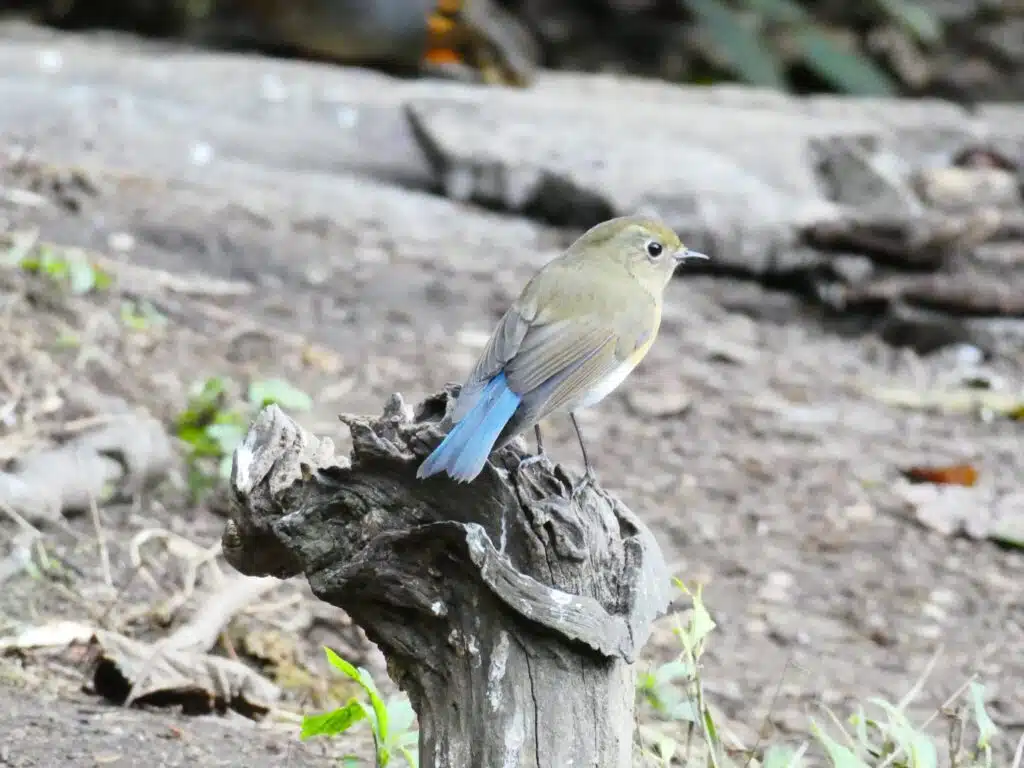
Blue is an important color for the male Himalayan Bluetail (Tarsiger rufilatus).
This species is dominated by blue dorsal nuances. In addition, it also shows a short dark blue tail.
Bright blue sections are seen on its lower back as well as just above the eyes.
Female Himalayan Bluetails are gray-brown but also show short blue tails.
This Southern Asian bird species is only found at high elevations. It lives among fir and pine trees for most of the year before descending to mixed woodlands for the winter.
Partly migratory, the species is further known to feed on insects such as small spiders, ants, flies, and larvae.
7. Burnished-Buff Tanager
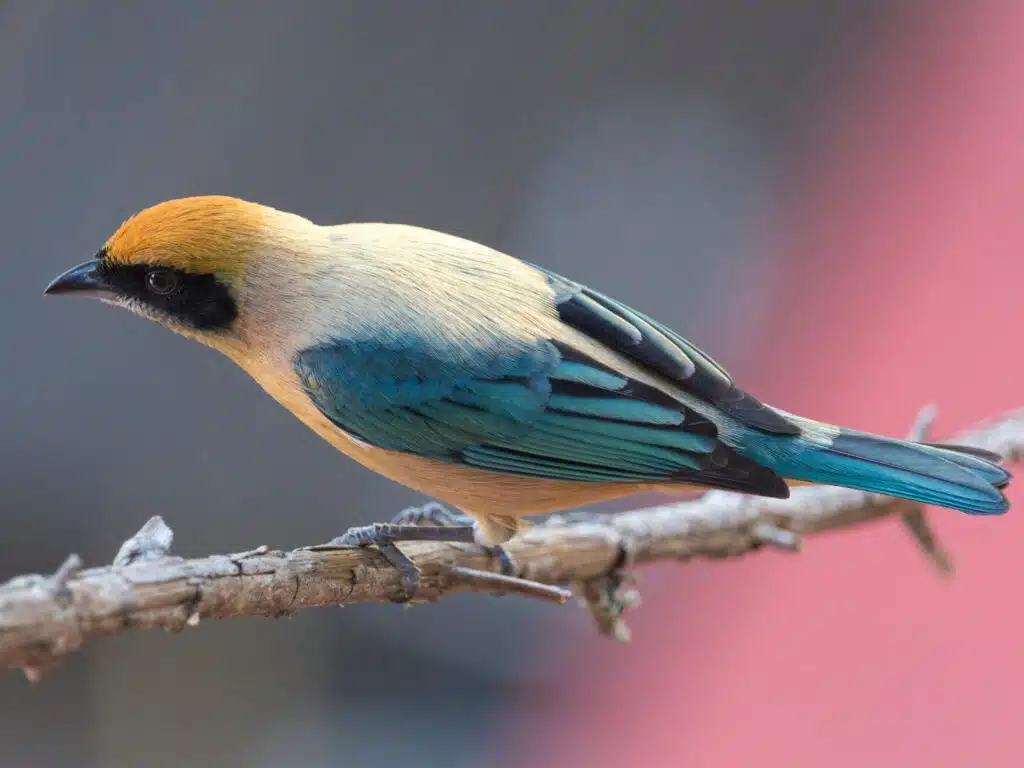
A species of buff birds in Northern South America, these types of blue-tailed species (Stilpnia cayana) have a bright appearance.
A bird with a few subspecies, it also shows blue sections across its black wings and tail. Its undertail is also blue.
Buff coloring is only contrasted by the black wings and the black mask around the eyes and beak.
A species of neotropical forests, The Burnished-Buff Tanager is a species that feeds on fruit.
Its diet doesn’t include all forest fruits but it favors small fruits such as those of pepper.
Despite these preferences, The Burnished-Buff Tanager is a species found across new habitats, including in inhabited areas.
8. Violet-Capped Woodnymph
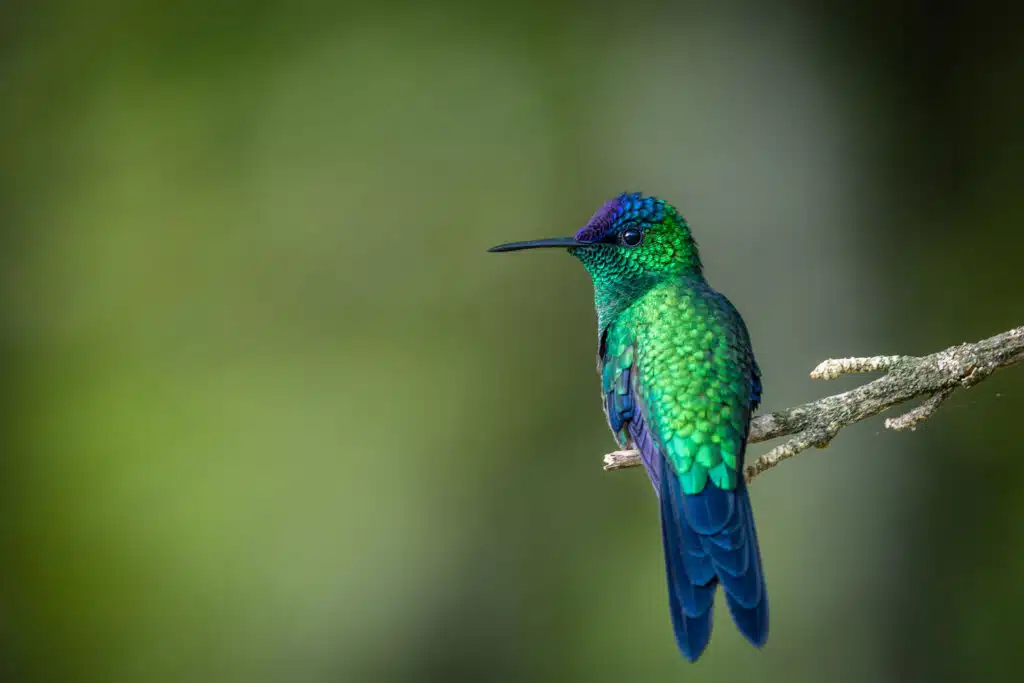
Reaching a size of up to 4 inches, The Violet-Capped Woodnymph (Thalurania glaucopis) has a long blue tail, in relation to the size of its body.
This is a species with blue-purple nuances, mostly visible on its head while its tail remains darker blue.
Southeastern Brazilian forests are home to The Violet-Cappted Woodnymph.
This type of bird of the forest is known for the blue-purple cap on males, a distinctive breeding trait.
Blue tails are also specific on males which are mostly iridescent green. Females have a similar appearance but a green cap and an off-white belly.
This is a species that lives up on trees and eats nectar. It doesn’t have particular preferences for certain plant species.
The most colorful period of the birds is marked by its breeding season, which begins in September.
Nests are built from vegetation with only 1-2 eggs being laid inside.
9. Yucatan Jay
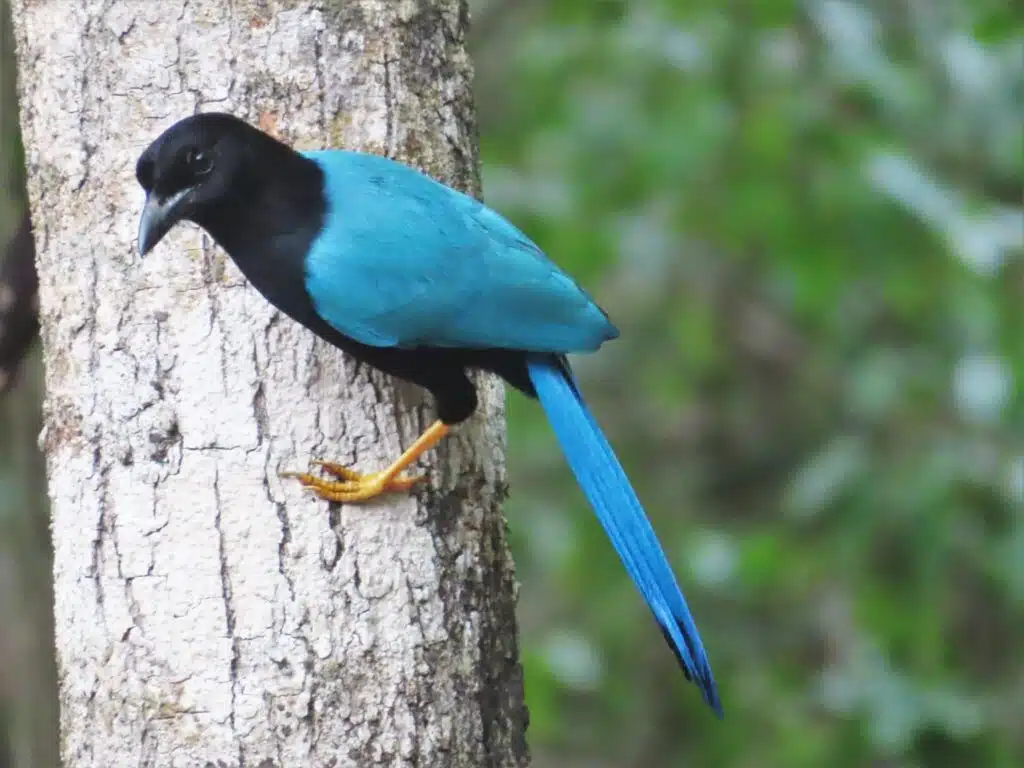
Blue tails and blue plumage is characteristic of The Yucatan Jay (Cyanocorax yucatanicus).
Mostly black on the chest, head, and underbelly, Yucatan Jays are actually born yellow and white.
They begin to darken as they molt and eventually end up having blue tails with matching wings.
A few yellow sections remain on this species. Such sections include those around the eyes as well as the yellow bill.
In addition, these birds have contrasting yellow legs.
These birds are also some of the larger ones with blue tails as they can reach a size of up to 12 inches.
Yucatan Jays are among the few Yucatan Peninsula species of this size with blue tails.
Tropical and subtropical forests represent their ideal habitat. Other types of forests may also be temporarily inhabited by this species.
10. Russet-Crowned Motmot
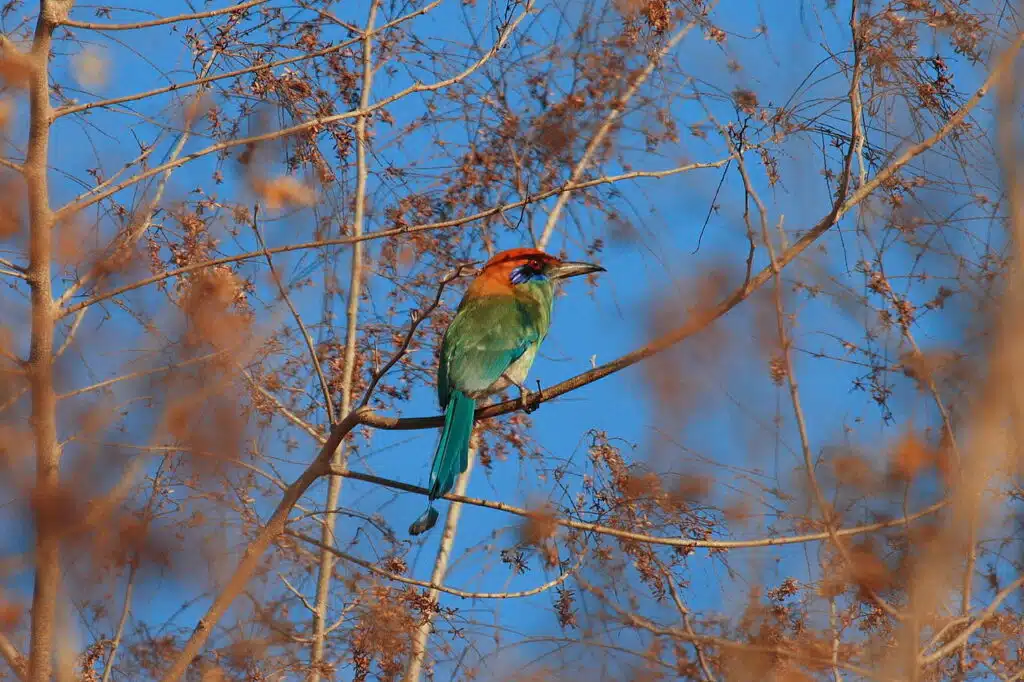
Blue-green tails and seen on adult Russet-Crowned Motmots (Momotus mexicanus).
This is a nuance only seen on the tails of adults as juveniles have a mostly gray appearance.
Blue nuances are also specific to the face of the birds, especially under the eyes.
Red-brown and yellow plumage completes the appearance of these multi-colored birds.
A highly sedentary species, The Russet-Crowned Motmot favors the same nesting locations each year.
It can perch on the same trees in the same areas due to its fidelity to a certain habitat, typically across Western and Southwestern Mexico.
Males and females form long-lasting partnerships. They take turns in providing for their young as well as early on in their incubation period.
11. Crimson Rosella
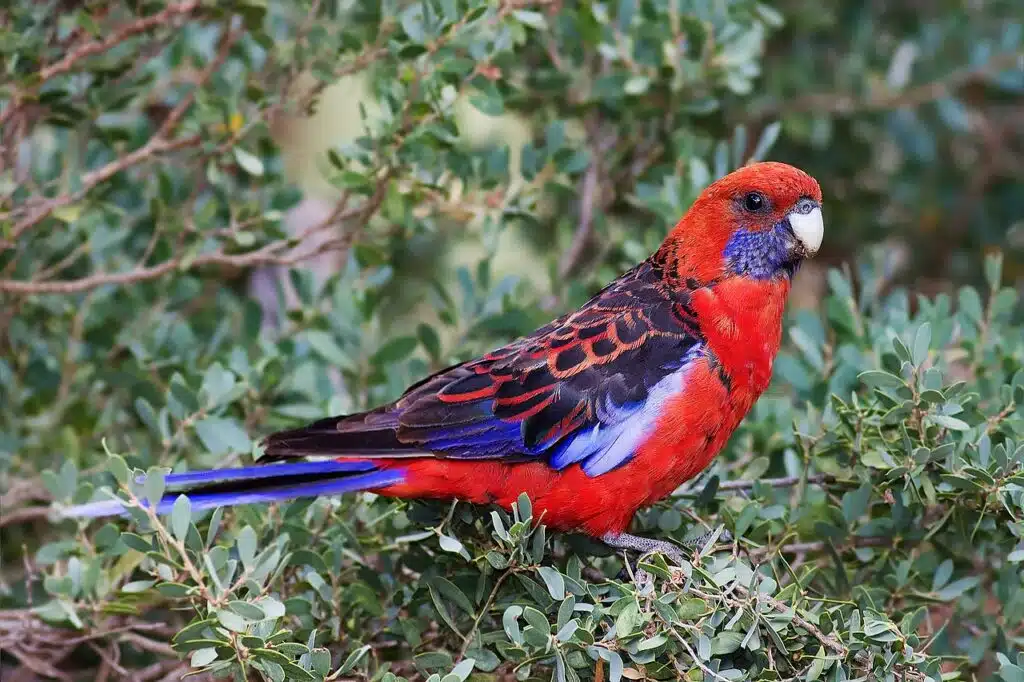
Vivid blue tails are specific to the crimson-red species of Crimson Rosella (Platycercus elegans).
Its tail is comprised of a blue gradient from dark to almost white. Measuring almost as long as its body, the blue tail matches the blue plumage on the underwing and on the face.
Black and red feathers are specific to the wings while the crest has a distinct crimson appearance.
As it grows, the species also grow its tail. It can even end up at a point where its blue tail is longer than its body.
A typical adult Crimson Rosella measures anywhere between 11 and 14 inches.
Just like The Yellow Rosella (also exhibiting a blue tail), The Crimson Rosella inhabits Eastern Australian territories.
12. Blue-Winged Kookaburra
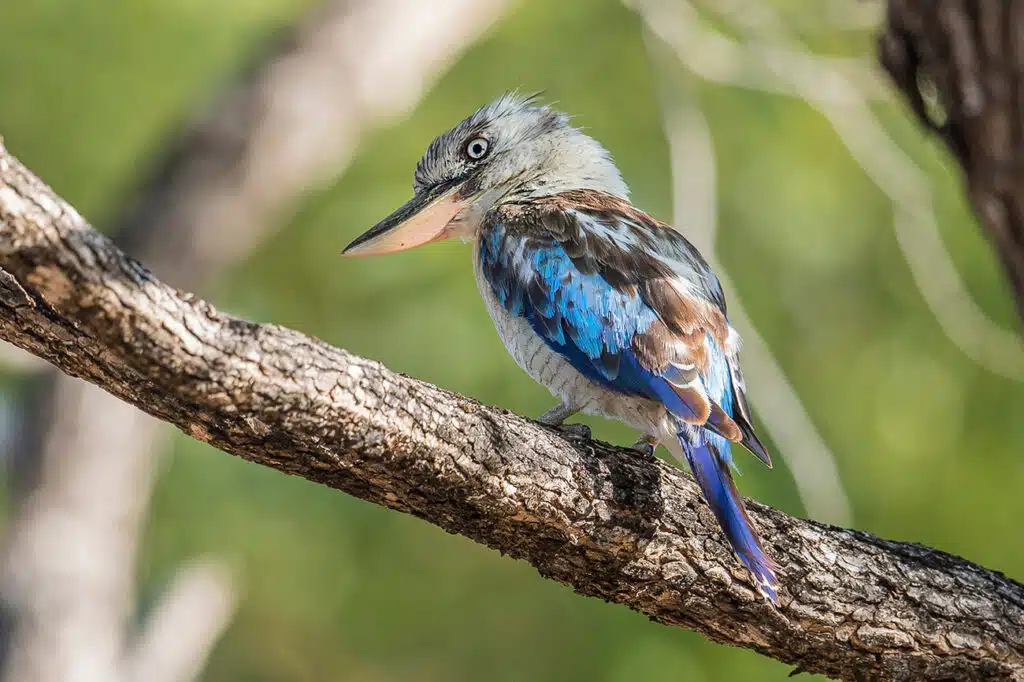
One of the largest blue-tailed birds in the world is The Blue-Winged Kookaburra (Dacelo leachii). This species reaches a size of up to 17 inches.
Only males exhibit blue tails, with a type of dark nuance, close to navy blue. Females have dark brown tails.
The male additionally shows bright blue coloring along the wings, similar to females.
Native to Eastern Australia, the birds show appearance adaptations into the breeding season. This is a time when males have a blue beak, alongside a blue tail.
Birds of this family breed in the Austral summer, only once per season. They repurpose hollows section of trees as a nest.
These are also loud birds with specific howl-like vocalizations.
13. Sri Lanka Blue-Magpie
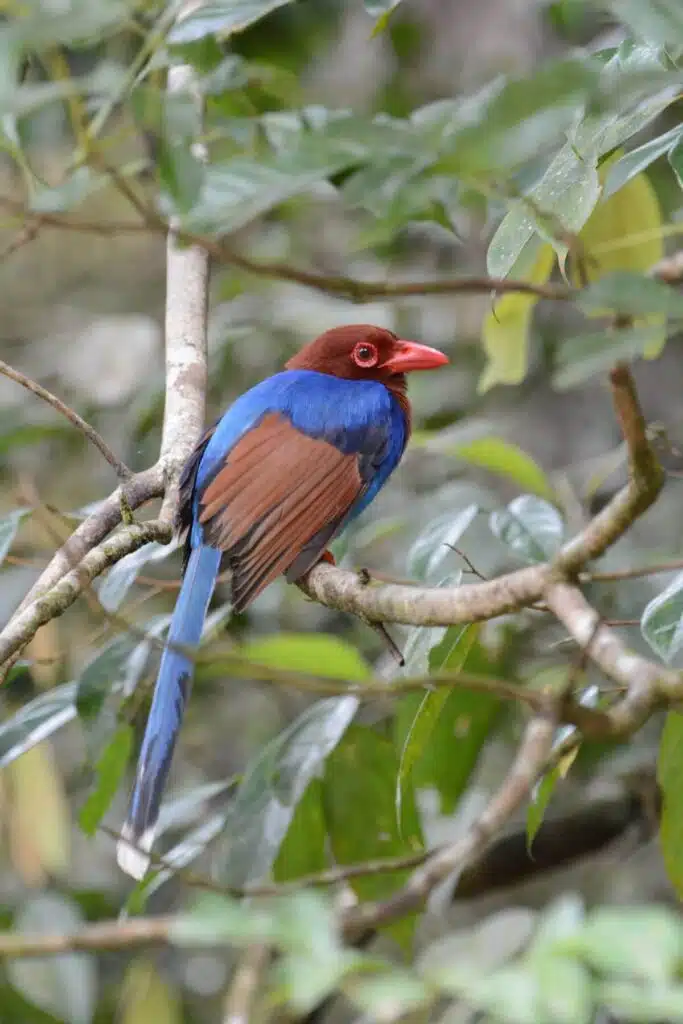
Mostly blue and red, The Sri Lanka Blue-Magpie (Urocissa ornata) is also large, measuring up to 11 inches.
This species is dominated by blue and red nuances, with a characteristic long vivid blue tail.
Measuring up to several inches, its blue tail is matched by the blue shoulders and chest while the wings have red coloring as the ones of the head.
Magpies of this family additionally exhibit vivid red beaks.
As a large bird, The Srin Langa Blue-Magpie has a varied diet, which includes insects and bugs.
This is also a species that feeds on fruit and can go to extreme lengths to get fruit. This includes having the capacity to hang and feed upside down.
A type of Corvidae bird, The Sri Lanka Blue-Magpie feeds opportunistically, just as regular crows.
This species lives and breeds in small groups, also known as flocks. Females of the species also work together for incubation and providing for their young.
14. Blue-Headed Pitta
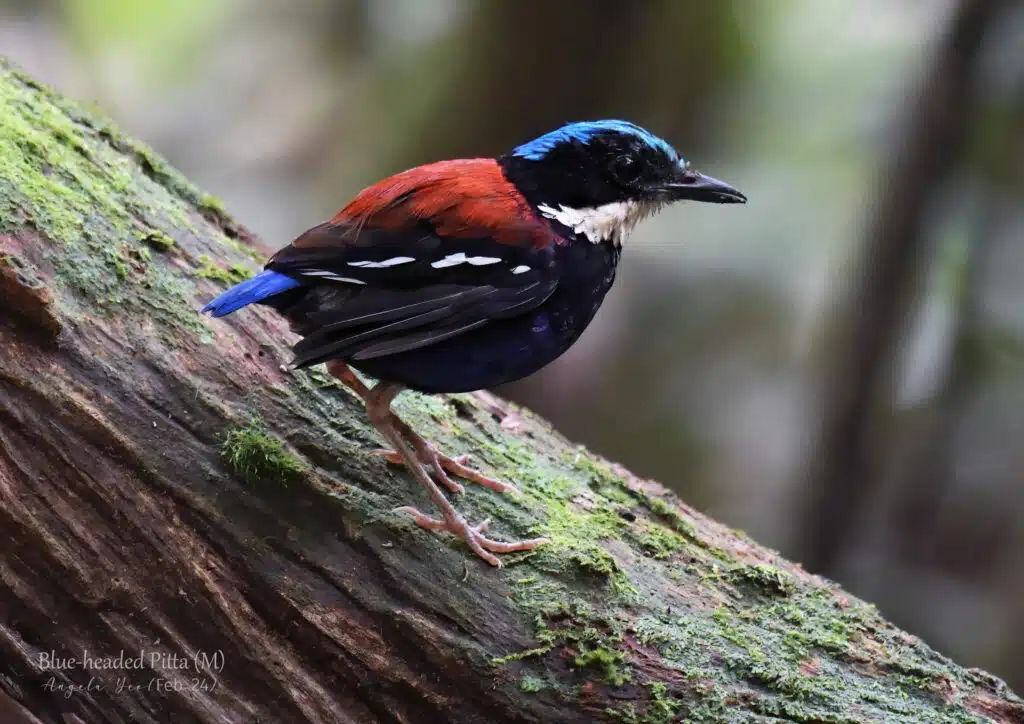
A species of tropical forests, Blue-Headed Pittas (Hydrornis baudii) are rare birds, mostly endemic to Brunei, Indonesia, and Malaysia.
This is a species known for its vivid blue tails and electric blue caps.
While males and females have different coloring, they share the same short vivid blue tail nuance.
Males have a brighter blue cap and a blue chest as well. Females are dominated by dull brown and red nuances.
Reaching a maximum size of just over 6 inches, the species is present in lowland forests.
Both male and female perching show their blue tails and blue undersides as they live higher among trees.
15. Rufous Motmot
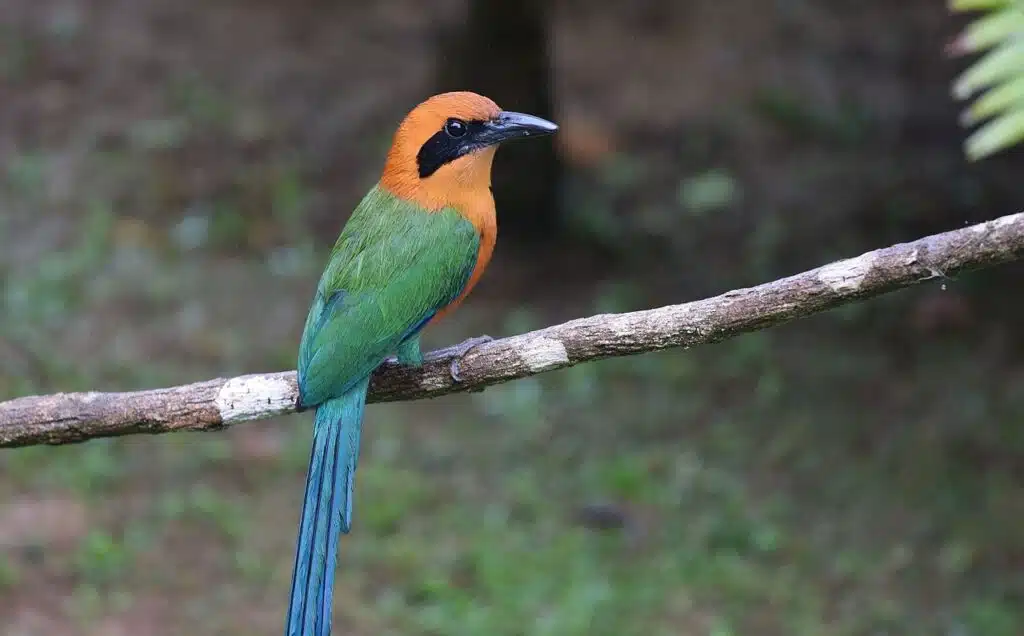
A thin long blue tail is specific to Rufous Motmots (Baryphthengus martii). These are some of the narrowest and longest blue tails in the world of birds.
A rufous (red-brown) color with cinnamon undertones is specific to this bird. It also features green wings with blue margins and a long curved black beak.
From Ecuador to Honduras, Rufous Motmots are found in old and new forests where they can perch or live on the ground.
These are also types of birds that nest in the ground.
As a species, Rufous Motmots represent solitary birds. The breeding season marks the only time of the year when these birds live in pairs.
The breeding season is marked by loud and deep noises and by higher activity under the canopy and even on the ground, seeking a good nesting site.